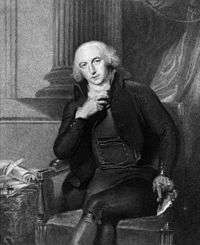Sylvester Douglas, 1st Baron Glenbervie
| The Right Honourable The Lord Glenbervie FRS FSA KC PC | |
|---|---|
 | |
| Chief Secretary for Ireland | |
|
In office 1793–1794 | |
| Monarch | George III |
| Prime Minister | Hon. William Pitt the Younger |
| Preceded by | Lord Hobart |
| Succeeded by | Viscount Milton |
| Personal details | |
| Born | 24 May 1743 |
| Died | 2 May 1823 (aged 79) |
| Nationality | British |
| Spouse(s) |
Lady Catherine North (1760–1817) |
| Alma mater |
University of Aberdeen University of Leyden |
Sylvester Douglas, 1st Baron Glenbervie of Kincardine PC, KC, FRS, FRSE, FSA (24 May 1743 – 2 May 1823) was a British lawyer, politician and diarist. He was Chief Secretary for Ireland between 1793 and 1794.
Background, education and legal career
Douglas was the son of John Douglas, descended from James Douglas, minister of Glenbervie in Aberdeenshire, son of Sir William Douglas, 9th Earl of Angus and half-brother of William Douglas, 9th Earl of Angus. His mother was Margaret Gordon, daughter and co-heir of James Gordon, of Fechel.[1] He was educated at the University of Aberdeen, graduating MA in 1765 and then studied both Law and Medicine at the University of Leyden. He was admitted to Lincoln's Inn in London in 1771, was called to the Bar in 1776, and became King's Counsel in 1793.[2]
Political career
The same year he was appointed a King's Counsel Douglas gave up his legal career on his appointment as Chief Secretary for Ireland under William Pitt the Younger.[3] In 1794 he was admitted to both the Irish[4] and English Privy Council[5] and returned to the Irish House of Commons for St Canice,[6] a seat he held until 1796. In 1795 he was elected to the British House of Commons for Fowey.[7] He later represented Midhurst between 1796 and 1800,[8] Plympton Erle between 1801 and 1802[9] and Hastings between 1802 and 1806.[10]
He was asked to accompany Earl Macartney to the Cape of Good Hope in 1796 and, after 18 months there, to succeed him as governor. His wife did not like the idea and he declined the offer, even though an Irish peerage had also been offered.[11] In 1797 Douglas was made a Lord of the Treasury by Pitt,[12] In 1800 Douglas was asked for a second time to go to the Cape as governor.[13] He finally agreed in October 1800, again for an Irish peerage and was so appointed Governor of the Cape of Good Hope,[14] Douglas changed his mind again and accepted a post as Joint Paymaster of HM Forces, subsequently receiving £2731. 10s. in salary, paid from the Cape Treasury, even though he never went there.[15] At the end of the year he was created Baron Glenbervie of Kincardine, in Scotland.
After serving as joint Paymaster of the Forces between 1801 and 1803[16] and Vice-President of the Board of Trade between 1801 and 1804,[17] he was Surveyor General of Woods, Forests, Parks, and Chases between 1803 and 1806[18] and 1807 and 1810. On the office of the Surveyor General of the Land Revenues of the Crown being combined with the former in 1810, became the First Commissioner of Woods and Forests, the head of the new department. He held the office until 1814.
Lord Glenbervie was also Rector of King's College, Aberdeen between 1805 and 1814.
Personal life
In 1789 Lord Glenbervie married Lady Catherine Anne, eldest daughter of Frederick North, Lord North.[19] Their only son Frederick Douglas sat as Member of Parliament for Banbury between 1812 and his early death in 1819.[20] Lady Glenbervie died in February 1817, aged 56. Glenbervie survived her by six years and died in May 1823, aged 79. As he had no surviving male issue the barony became extinct on his death.[19]
In 1795 he was elected a Fellow of the Royal Society of London [21] and in 1806 elected a Fellow of the Royal Society of Edinburgh, when his proposers were Allan Maconochie, Lord Meadowbank, Gilbert Innes and John Playfair.[22]
References
- ↑ A Biographical Peerage of the Empire of Ireland. London, 1817.
- ↑ The London Gazette: no. 13500. p. 107. 5 February 1793.
- ↑ leighrayment.com Peerage: Gage to Glendale
- ↑ leighrayment.com Privy Counsellors – Ireland
- ↑ The London Gazette: no. 13652. p. 410. 6 May 1794.
- ↑ leighrayment.com Irish House of Commons 1692–1800
- ↑ leighrayment.com House of Commons: Fairfield to Fylde South
- ↑ leighrayment.com House of Commons: Mayo to Minehead
- ↑ leighrayment.com House of Commons: Plymouth to Putney
- ↑ leighrayment.com House of Commons: Haslemere to Herefordshire
- ↑ Thorpe, History of Parliament online, Sylvester Douglas
- ↑ The London Gazette: no. 13974. p. 75. 24 January 1797.
- ↑ George McCall Theal, Records of the Cape Colony, Vol. III, Cape Town: Gov’t of the Cape Colony, 1898, p. 408.
- ↑ The London Gazette: no. 15332. p. 125. 27 January 1801.
- ↑ Theal, Records Vol. III, p. 491
- ↑ The London Gazette: no. 15346. p. 306. 17 March 1801.
- ↑ The London Gazette: no. 15428. p. 1383. 17 November 1801.
- ↑ The London Gazette: no. 15547. p. 34. 4 January 1803.
- 1 2 thepeerage.com Sylvester Douglas, 1st and last Baron Glenbervie
- ↑ Catalogue of the papers of Frederick Sylvester North Douglas at www.bodley.ox.ac.uk
- ↑ "Fellows details". Royal Society. Retrieved 23 May 2016.
- ↑ BIOGRAPHICAL INDEX OF FORMER FELLOWS OF THE ROYAL SOCIETY OF EDINBURGH 1783 – 2002 (PDF). The Royal Society of Edinburgh. July 2006. ISBN 0 902 198 84 X.
External links
- Hansard 1803–2005: contributions in Parliament by Sylvester Douglas
- "Archival material relating to Douglas, Sylvester (1743–1823) Baron Glenbervie, politician". UK National Archives.